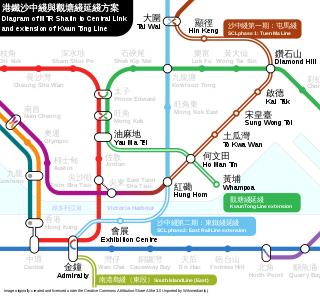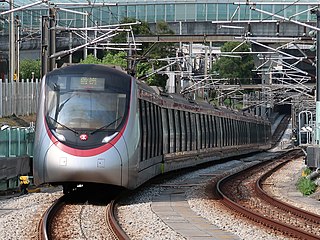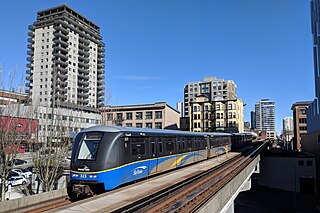
The Mass Transit Railway (MTR) is a major public transport network serving Hong Kong. Operated by the MTR Corporation Limited (MTRCL), it consists of heavy rail, light rail, and feeder bus service centred on a 10-line rapid transit network serving the urbanised areas of Hong Kong Island, Kowloon, and the New Territories. The system included 240.6 km (149.5 mi) of rail as of 2022 with 167 stations, including 98 heavy rail stations, 68 light rail stops and one high-speed rail terminus.

The Tsuen Wan line is one of the ten lines of the metro network in Hong Kong's MTR. It is indicated in red on the MTR map.

Innovia Metro is an automated rapid transit system manufactured by Alstom. Innovia Metro systems run on conventional metal rails and pull power from a third rail but are powered by a linear induction motor that provides traction by using magnetic force to pull on a "fourth rail" placed between the running rails. However, newer versions of the technology are available with standard electric rotary propulsion.

The Ma On Shan line was a rapid transit line that formed part of the Mass Transit Railway (MTR) system in Hong Kong. Coloured brown on the MTR map, the line acted as a branch of the East Rail line that connects the new towns of Sha Tin and Ma On Shan in the northeastern New Territories.

An elevated railway or elevated train is a railway with the tracks above street level on a viaduct or other elevated structure. The railway may be broad-gauge, standard-gauge or narrow-gauge railway, light rail, monorail, or a suspension railway. Elevated railways are normally found in urban areas where there would otherwise be multiple level crossings. Usually, the tracks of elevated railways that run on steel viaducts can be seen from street level.

Platform screen doors (PSDs), also known as platform edge doors (PEDs), are used at some train, rapid transit and people mover stations to separate the platform from train tracks, as well as on some bus rapid transit, tram and light rail systems. Primarily used for passenger safety, they are a relatively new addition to many metro systems around the world, some having been retrofitted to established systems. They are widely used in newer Asian and European metro systems, and Latin American bus rapid transit systems.

The Sha Tin to Central Link was an expansion project of the MTR public transport network in Hong Kong. It was divided into two sections and expanded the network’s heavy rail lines.
The Toronto subway uses a variety of signalling systems on its lines, consisting of a combination of fixed block signalling and moving block signalling technologies.

A medium-capacity system (MCS), also known as light rapid transit or light metro, is a rail transport system with a capacity greater than light rail, but less than typical heavy-rail rapid transit. MCS's trains are usually 1–4 cars, or 1 light rail vehicle (LRV). Most medium-capacity rail systems are automated or use light rail type vehicles. Light rail is considered high capacity as trains use 2–4 LRVs.

Incheon Subway Line 2 is a driverless, medium-capacity subway line running 29.2 km (18.1 mi) from Oryu-dong in Seo-gu to Incheon Grand Park, with 27 stations, part of the Incheon Subway system. The line is also included as a part of the overall Seoul Metropolitan Subway network; Juan station has a free transfer with Seoul Subway Line 1, Geomam station connects with the AREX Line to Incheon International Airport and Seoul Station, and Seongnam also has a free transfer with Seoul Subway Line 7.

The Busan–Gimhae Light Rail Transit is a light metro system between the cities of Busan and Gimhae in South Korea. The line has 21 stations including Daejeo and Sasang where passengers can transfer to Busan Metro Line 3 and Line 2 respectively. The line thus acts as a connecting rail between both Gimhae and Busan International Airport with two western outreaches of the Busan Metro system.

The Tuen Ma line is a rapid transit and commuter rail line that forms part of the Mass Transit Railway (MTR) system in Hong Kong. Coloured brown on the map, the Tuen Ma line is 56.2 kilometres (34.9 mi) in length, making it the longest line of the MTR network. It has a total of 27 stations, more than any other in the MTR system.
Thales Rail Signalling Solutions is a division of Thales Group that supplies transportation-based automation solutions for railways. Its operations are controlled from several locations:

Communications-based train control (CBTC) is a railway signaling system that uses telecommunications between the train and track equipment for traffic management and infrastructure control. CBTC allows a train's position to be known more accurately than with traditional signaling systems. This makes railway traffic management safer and more efficient. Metros are able to reduce headways while maintaining or even improving safety.
CITYFLO 650 signalling is a CBTC system designed by Bombardier Transportation. It makes use of bi-directional radio communication between trains and wayside equipment, as well as true moving block technology, to control train operation. Trains report their position via radio, and a wayside signalling system provides movement authorities to the trains via a radio link.

The MTR Urban Lines Vision Train is a new rolling stock ordered by MTR Hong Kong in July 2015. They began replacing all of the aging Metro-Cammell EMU (DC) trains starting from 27 November 2022. The order currently consists of 744 cars.

The Joo Koon rail accident, or sometimes referred to as the Joo Koon train collision, was an accident which happened on 15 November 2017, when a C151A train travelling at 16 kilometres per hour (9.9 mph) rear-ended a stationary C151A train at Joo Koon station on the East West MRT line, resulting in 38 injuries. The stationary train was in the process of being detrained due to a train fault. Both trains were operating under the recently installed Thales SelTrac CBTC signalling system at time of incident, and the Minister of Transport Khaw Boon Wan expressed that he was "disturbed" by an initial finding that "critical safety software" was inadvertently removed from the stationary train, possibly due to a malfunctioning signalling circuit, which led to the accident. This incident is the second train collision in Singapore MRT's history, after the Clementi rail accident.

Urban rail transit in Canada encompasses a broad range of rail mass transit systems, including commuter rail, rapid transit, light rail, and streetcar systems.














